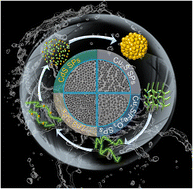Versatile fabrication of metal sulfide supraparticles by an in situ decomposition–assembly strategy†
Abstract
Supraparticles (SPs) are of great importance in both fundamental and applied studies due to their emerging collective properties, synergistic effects, and various applications. Metal sulfide nanomaterials are of vital importance in biomedicine, catalysis, battery materials, and other fields. Herein, an in situ decomposition–assembly strategy for the versatile fabrication of metal sulfide SPs is developed. In the fabrication, cysteine molecules and metal cations first react and form coordination polymers, which are then decomposed by heating to produce small-sized metal sulfide nanocrystals. Driven by elimination of the high surface energy of NCs generated by thermal decomposition and the van der Waals attraction, the resulting nanocrystals in situ self-assemble each other and form SP products. In addition to homogeneous Cu2S, CdS, and ZnS products, the proposed system can even be extended to fabricate hybrid Cu2S/Fe2O3 SPs. Furthermore, the SP size can be easily tuned from 10 to 100 nm by adjusting the proportion of cysteine and metal ions. The SPs not only exhibit various properties including photothermal conversion, fluorescence, and magnetism, depending on their composition, but can also combine these properties by the formation of hybrid structures.

- This article is part of the themed collections: Celebrating Nanoscience in China and Top articles from NCNST


 Please wait while we load your content...
Please wait while we load your content...